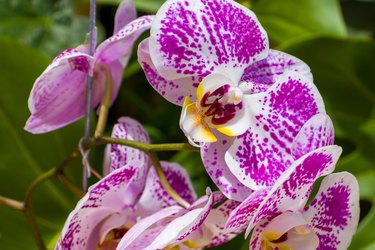
Your orchid (Orchidaceae) loses all its flowers naturally after weeks or months of blooming. Since the beautiful blooms are the star of the show, the orchid plant looks bare and plain without it, but you don't need to toss it out. When the flowers fall off, the orchid goes into a resting period while the plant replaces nutrients to prepare to bloom again. This period can naturally last six to nine months, but you can help the process along by giving the plant special care during that time.
Tip
After your orchid loses its flowers, trim the flower spike when it turns brown and move your orchid to a spot with bright, indirect light. Water your orchid regularly and fertilize it weekly to encourage new growth.
Video of the Day
Why Orchids Lose Their Flowers
Orchids naturally lose their blooms once the older flowers are done blooming. The flowers typically fall off one at a time, starting near the crown and working toward the tip. This process is natural, and there's no way to stop it. The orchid might look dead, but it's often healthy and just waiting to regrow more blooms.
Video of the Day
Sometimes, though, the flowers fall off prematurely due to growing conditions. A sudden change in temperature, light or humidity can cause shedding of the flowers due to the shock it causes. This type of flower loss usually involves all flowers falling at once. Correcting the environmental issues and keeping conditions consistent can prevent this.
Check the Flower Spike
When your orchid loses all its flowers, check the flower spike, which is the the thin stalk on the orchid plant. A healthy flower spike looks green and plump. If the spike looks dried up or is brown or yellow, prune the orchid to help with regrowth. The plant's energy is better spent on a healthy spike.
As long as the spike stays green, however, you may want to leave it attached to the plant because it may rebloom or produce a baby orchid plant, called a "keiki."
Sterilize your pruning shears using alcohol before trimming the spike. If the entire spike is brown, you can cut off the whole thing about 1 inch above the base. Otherwise, cut the spike a little above one of the nodes, which are bumps along the spike. Cut just above the node.
Choose an Ideal Location
Ideal growing conditions can potentially help your orchid rebloom faster by giving it the environment it needs to thrive. Orchids grow best with bright, indirect light. If your orchid is sitting in direct sunlight, move it to a spot out of the direct rays. A slightly cooler location, ideally between 55 and 65 degrees Fahrenheit, can also benefit an orchid that's in its resting period. If your orchid loses all its flowers and doesn't rebloom for months, try relocating it.
Fertilize Your Orchid
Fertilizing the orchid gives it the nutrients it needs while it prepares to grow new blooms. Use orchid fertilizer to ensure your plant gets the proper nutrients. Fertilize the orchid weekly using the package instructions as a guide. To protect the roots, water the orchid before fertilizing.
Continue Watering Your Orchid
After your orchid loses all its flowers, it still needs consistent moisture. Continue with your normal watering routine. Wait until the soil is mostly dry since too much moisture can damage the roots and eventually kill the plant. Stick your finger in the potting mix to see if it's moist, or pick up the pot to see if it feels lighter than normal, which means the soil is dry.
Support the Flower Spike
If you cut the flower spike down to the base, the new flower spike will benefit from support. Once it's around 5 inches tall, support the spike with a stake. Tie the flower spike loosely to the stake to prevent damage.